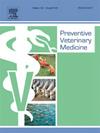Combining different sources of movement data to strengthen traceability and disease surveillance
IF 2.2
2区 农林科学
Q1 VETERINARY SCIENCES
引用次数: 0
Abstract
Recent concerns with food safety in the United States have highlighted the importance of traceability systems in animal production chains. Yet, adoption of these systems presents various challenges. Interstate Certificates of Veterinary Inspection (ICVIs) are required for most interstate animal movements and are considered the most representative source of livestock movement data. However, exceptions exist, where Owner Shipper Statements (OSSs) are often used as an alternative but previously unexplored. Calf movement networks are understudied, yet important in understanding animal and human disease transmission dynamics. The objective of this study was to use movement records to describe calf networks within a US region and explore how the inclusion of OSSs impact the structure of calf networks built using ICVIs. Calf movement records to and from Ohio were obtained through ICVIs and OSSs from June 2021 to June 2022. To explore and compare movement patterns, network analysis was performed individually for an ICVI-based network and a network combining both document types. Zip codes were considered nodes and calf movements (cattle up to 4 months) were considered links. Whole-network and node-level parameters were calculated, and Mann-Whitney U tests were performed to evaluate statistical differences by network type. Community detection was performed to investigate the underlying structure of calf networks in Ohio. The frequency of animal movements recorded through OSS (n = 766, 49.8 %) and ICVIs (n = 772, 50.2 %) was similar. Most animal movements included mixed sex (60.0 %), dairy breeds (81.6 %) and animals up to one week old (74.1 %). There were major differences in the network structure with OSSs compared to ICVIs exclusively. Movements recorded through OSSs showed larger median number of animals per movement (60; IQR 23–105) compared to ICVIs (49; IQR 16–80); reaching up to 696 calves per batch of transported calves. Failing to include OSSs would have resulted in an incomplete network, excluding 40.3 % of the zip codes (n = 206) represented in this database. The ICVI-based network involved fewer zip codes across states, whose connections were sparser than in the combined network. The two analyzed networks revealed contrasting centrality results, especially for out-going geographical regions (P < 0.01), suggesting a discrepancy in their potential to influence disease transmission dynamics. Moreover, including OSSs resulted in a network with lower closeness centrality scores (P < 0.01). Results suggested heterogeneous patterns of calf movements, depending on the source of records, and emphasized the importance of incorporating multiple sources of movement data for the development of targeted disease surveillance strategies, particularly using community detection analysis.
结合不同来源的移动数据,加强可追溯性和疾病监测。
美国最近对食品安全的关注凸显了动物生产链中可追溯系统的重要性。然而,采用这些系统带来了各种各样的挑战。大多数州际动物流动都需要州际兽医检验证书(ICVIs),被认为是牲畜流动数据最具代表性的来源。但是,也存在例外,即所有者托运人声明(OSSs)通常被用作替代方案,但以前未被探索过。小牛运动网络尚未得到充分研究,但对理解动物和人类疾病传播动力学很重要。本研究的目的是使用运动记录来描述美国地区的小牛网络,并探索OSSs的包含如何影响使用ICVIs构建的小牛网络结构。从2021年6月到2022年6月,通过ICVIs和OSSs获得了进出俄亥俄州的小牛运动记录。为了探索和比较移动模式,分别对基于icvi的网络和结合两种文档类型的网络进行了网络分析。邮政编码被认为是节点,小牛运动(4个月以内的牛)被认为是链接。计算全网络和节点级参数,并采用Mann-Whitney U检验评估网络类型的统计差异。采用群落检测方法对俄亥俄州小牛犊网络的底层结构进行了调查。通过OSS (n = 766,49.8 %)和ICVIs (n = 772,50.2 %)记录的动物运动频率相似。大多数动物运动包括混合性别(60.0 %)、奶牛品种(81.6 %)和1周龄以下动物(74.1 %)。与ICVIs相比,OSSs的网络结构存在重大差异。通过OSSs记录的运动显示,每次运动的动物中位数较大(60;IQR 23-105)与ICVIs (49;差16 - 80);每批运送的小牛多达696头。如果不包含开源软件,将导致网络不完整,排除了该数据库中表示的40.3% %的邮政编码(n = 206)。基于icvi的网络涉及各州的邮政编码较少,其连接比合并后的网络更稀疏。两种分析的网络显示出截然不同的中心性结果,特别是在对外地理区域(P
本文章由计算机程序翻译,如有差异,请以英文原文为准。
求助全文
约1分钟内获得全文
求助全文
来源期刊

Preventive veterinary medicine
农林科学-兽医学
CiteScore
5.60
自引率
7.70%
发文量
184
审稿时长
3 months
期刊介绍:
Preventive Veterinary Medicine is one of the leading international resources for scientific reports on animal health programs and preventive veterinary medicine. The journal follows the guidelines for standardizing and strengthening the reporting of biomedical research which are available from the CONSORT, MOOSE, PRISMA, REFLECT, STARD, and STROBE statements. The journal focuses on:
Epidemiology of health events relevant to domestic and wild animals;
Economic impacts of epidemic and endemic animal and zoonotic diseases;
Latest methods and approaches in veterinary epidemiology;
Disease and infection control or eradication measures;
The "One Health" concept and the relationships between veterinary medicine, human health, animal-production systems, and the environment;
Development of new techniques in surveillance systems and diagnosis;
Evaluation and control of diseases in animal populations.
 求助内容:
求助内容: 应助结果提醒方式:
应助结果提醒方式:


